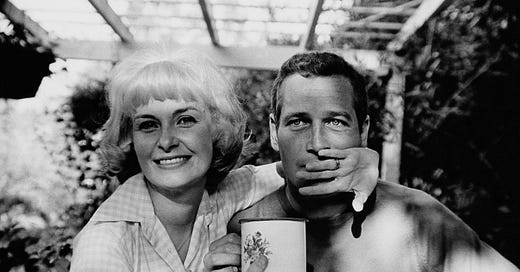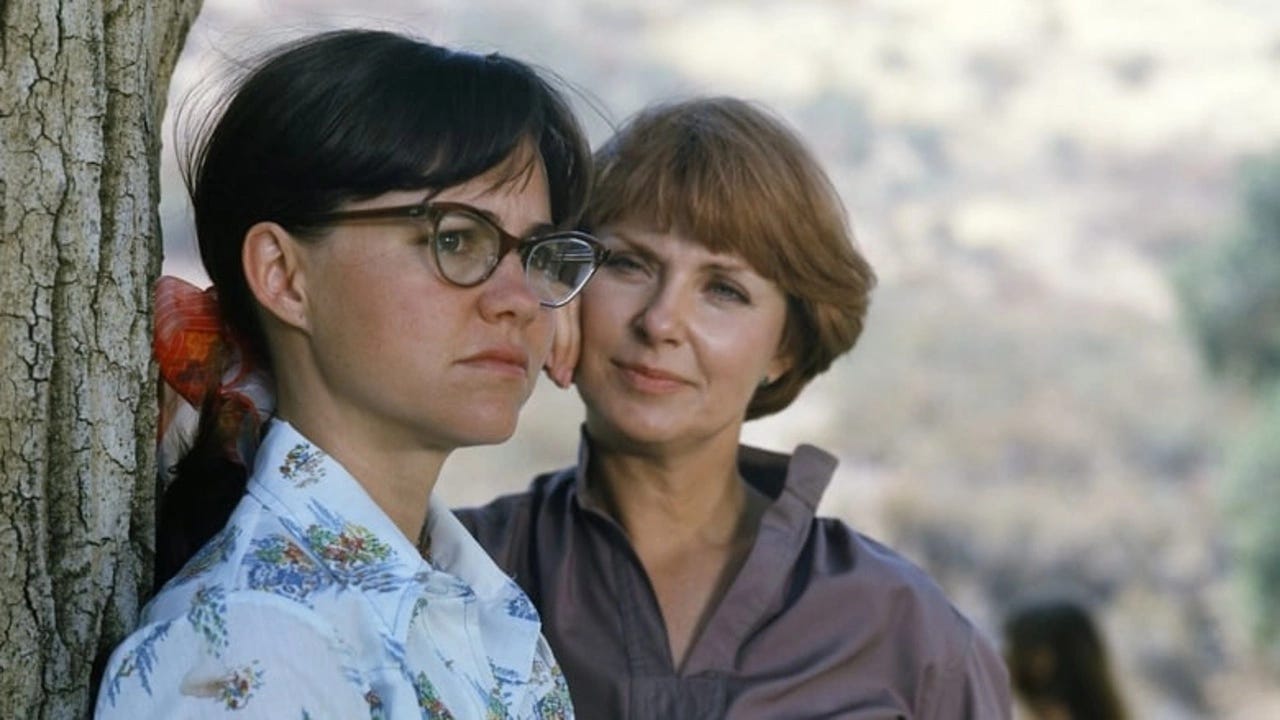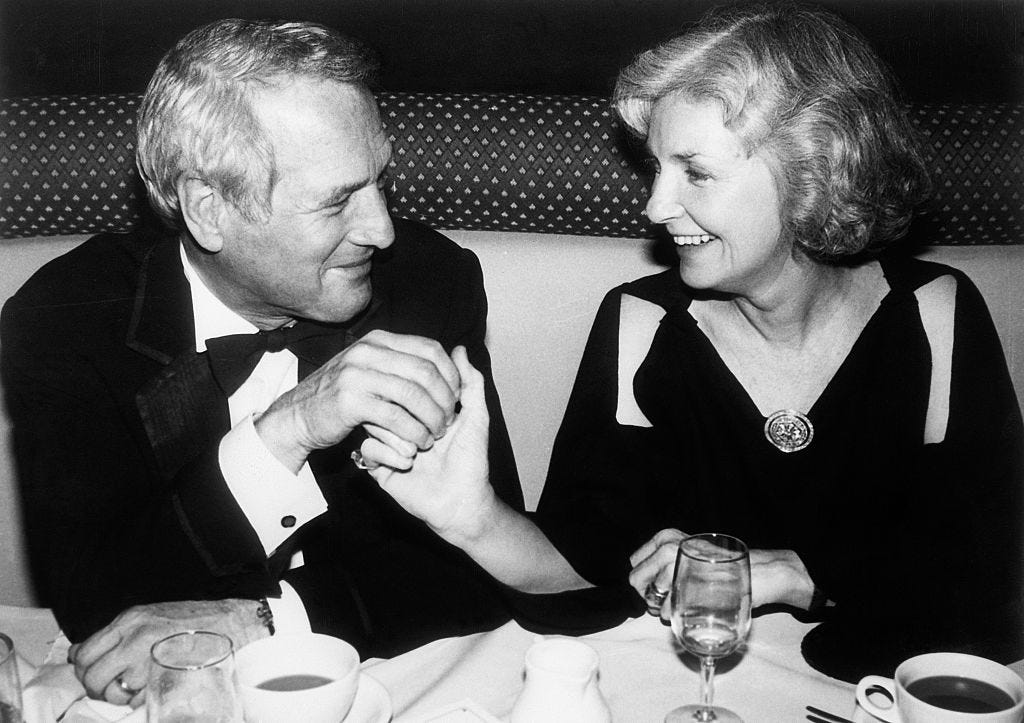Scenes from a Hollywood Marriage
"The Last Movie Stars," a six-part HBO Max documentary about Paul Newman and Joanne Woodward, is irresistible pop history.
The cliché about Joanne Woodward and Paul Newman was that she was the Great Actress and he was the Great Star. And to a certain extent, “The Last Movie Stars” (**** stars out of ****) Ethan Hawke’s wonderful, addictive six-part documentary about the couple, bears that out. (All six episodes are available on HBO Max starting today.) At one point, Hawke asks the young actress Zoe Kazan if she has seen a single movie Woodward starred in. Embarrassed, she admits she hasn’t, and I think most reasonably culturally literate people might draw a blank after “The Three Faces of Eve,” which won the star her Oscar. Whereas a lot of us can reel off up to ten Paul Newman films we have under our belts without blinking. “Cool Hand Luke,” “Hud,” “Butch Cassidy and the Sundance Kid,” “The Sting,” “The Verdict,” “The Hustler,” “The Color of Money,” “Slap Shot,” “Cat on a Hot Tin Roof,” “The Towering Inferno.” There. “Cars” if you have kids or are a Pixar completist.
In fact, Newman and Woodward starred in ten movies together over the course of their long-married lives – they’re just not the movies people tend to remember. (Newman also directed his wife in a number of films, including the peerless “Rachel, Rachel,” from 1968.) One of the many values of Hawke’s documentary, deep-sourced with material I’ll get to in a bit, is that it forces you to scribble down a long must-watch and need-to-revisit list of movies that were panned or passed over in their day but whose clips here exert a siren call. Some of them are Newman’s own – the two with Robert Altman (“Quintet,” “Buffalo Bill and the Indians, or Sitting Bull’s History Lesson”) – and some are Woodward’s (“The Stripper,” “The Effects of Gamma Rays on Man-in-the-Moon Marigolds,” all those late-life TV movies). But what on earth is “A New Kind of Love,” a screwball romance from 1963 that co-stars Thelma Ritter, Eva Gabor, and Maurice Chevalier as himself? And why has no one singled out Woodward’s performance in “WUSA” (1970), as sexily confident as anything her husband ever did?
What raises “The Last Movie Stars” up toward greatness, though, is its gentle but firm deconstruction of a much-loved legend in favor of something as close to the truth as we’ll ever get. Here the filmmaker’s perspective genuinely matters. Hawke has created a “Scenes from a Hollywood Marriage,” intimate and raw and human, in part because he approaches Newman and Woodward as a fellow actor and a movie star as well as a fan. He knows the wreckage that celebrity can make of personal relationships and the insecurity that comes from understanding all the characters you play while never quite knowing yourself. I think he probably understands the ways public adoration can feed the needs and widen the flaws in oneself. “The Last Movie Stars” is co-produced by Hawke’s second wife, Ryan, and includes a touching father-daughter conversation with Maya Hawke, his first child by first wife Uma Thurman. So there are many points of contact here, all of which bear fruit.
There are also Newman’s and Woodward’s own words, his from beyond the grave and hers from behind the veil of Alzheimers, with which she was diagnosed in 2007, as well as the many voices of colleagues, family, and friends. I’m burying the lede, I guess: In 1991, Newman began a memoir project, with writer Stuart Stern ultimately interviewing over 100 people on audiotape. Seven years later, for reasons unknown, the actor burned those tapes, including his own, at the local dump, but thousands of pages of typed transcripts survived, and “The Last Movie Stars” resurrects Newman, Woodward, and their circle by having well-known actors read those transcripts in an attempt to create, in Hawkes’ words, “a kind of play with voices.” So in addition to film clips, archival footage, talk show appearances from the ‘60s and ‘70s, new interviews with the couple’s surviving daughters, and a lot of Zoom conversations with the filmmaker and his notable friends – this is very much a COVID-era production – we have Paul Newman’s recollections from the early 1990s performed by an offscreen George Clooney. Laura Linney “plays” Joanne Woodward.
Sam Rockwell, Josh Hamilton, Tom McCarthy, and Oscar Isaac provide the voices of directors Stuart Rosenberg, George Roy Hill, Sidney Lumet, and Sydney Pollack. Zoe Kazan is Newman’s first wife, actress Jackie Witte, left with three young children once her husband met Woodward and the earth shook. Vincent D’Onofrio contributes a dab John Huston impression, and stage actor Brooks Ashmanskas channels Gore Vidal – a friend of the stars from their starveling days – with haughty authority. Martin Scorsese doesn’t play anyone but himself, obviously, but he’s on hand to talk about “The Color of Money” and dispense general wisdom, and Sally Field does some minor character voicing but, more movingly, tells of how she was lifted out of the “Gidget”/”Flying Nun” sitcom graveyard by Woodward’s mentorship on the 1976 TV movie “Sybil” (below).
So help me, it works. None of these actors forces their performance, and the effect is of putting one’s ear up to the wall of fame and hearing, clearly, the voices on the other side. The interviews with daughters Susan and Stephanie (from Newman’s marriage to Witte), and Nell, Lissy, and Clea Newman provide additional perspective, the kind only children who’ve seen monumental parents at their best and worst can provide. The missing piece, of course, is Newman and Witte’s son, Scott, who died in 1978, at 28, of a drug overdose, and whose sad life rises and ebbs over the course of the first five episodes. To be the son of the world’s most magnetic male movie star must be a special kind of hell, and Hawkes’ documentary, to its credit, does nothing to suggest the father made it any easier.
When I mentioned on social media that I was screening “The Last Movie Stars,” someone responded, “Just don’t tell me Newman was an awful jerk. I couldn’t deal with that.” Which goes to the halo of esteem we extend to certain famous people and to this one in particular. Paul Newman was one of 20th century pop culture’s best arguments for the human species and certainly for the American male. He seemed playful and serene, at ease in his own body, even when he was playing rat bastards like Hud; it drove him a little crazy that he came out of that movie more beloved than he went in. And he aged well, onscreen at least. “The Verdict” remains the Best Actor Oscar he should have won because we sense and see and feel the accumulation of regret that has sunk Frank Galvin to the bottom, from which there is no way out but up.
It's shocking, then, to hear director Sidney Lumet (voiced by ”Spotlight” director McCarthy), tell of how uninspired, how spent, Newman was at the beginning of the “Verdict” shoot, to the point where Lumet read him the riot act and sent him home. (“We broke for the weekend and came back, and it was like a different actor.”) “I don’t know what happened to Paul during the middle years,” says director Arthur Penn, and what happened, according to everyone here, was a run of lousy movies and work-for-hire, a drinking problem far more serious than anyone outside the family knew, and a marriage that was rocked by ego, intransigence, and (glanced at only slightly here) infidelity. The legend held in the public eye: Newman and Woodward lived celebrity marriage the way many of us thought it should be lived: off the Hollywood grid in Connecticut, devoted to charitable work and political activism, and not taking any of it seriously except for other people and the art. The reality was less pretty. It always is.
“The Last Movie Stars” is necessary viewing not just to rekindle our fondness for one star, or both, or the era in which they lived and worked, but also to tear down the wall of myth with which we surround our idols. Everyone here does so with love. Daughter Melissa Newman speaks for all when she says, “To a certain extent, I feel guilty dismantling that story, because I feel everybody needs those kinds of heroes. But at the same time, I think they deserve more credit than that.”
The final revelation prompted by Hawkes’ documentary is a long-belated appreciation for Woodward, a great actress who starred in movies without quite being a Movie Star and an ambitious artist who took many years to forgive her husband for going off and seducing the world while she stayed at home with the kids. (“I didn’t let anything get in my way until I had children,” Woodward says in the memoir tapes. “If I had to do it all over again, I might not have had children. Actors don’t make good parents.”) The portrait that emerges from “The Last Movie Stars,” through the memories read by Linney and in talk show appearances and interviews throughout the actress’s life, is of a hard-headed, clear-eyed woman with a substantial ego and a resentment that her creative gifts – which everyone implicitly acknowledged ran deeper than her husband’s, at least initially – never got the attention they deserved. “She was also very difficult,” says Melissa Newman in the film. “She was mercurial, she was anxiety driven, she could hold a grudge, she could be very dark and moody. And she could be fiercely loving — she wasn’t easy.”
Somehow, in “The Last Movie Stars,” you come out admiring the couple more for surviving, and for surviving together. The final decades – the years of “Mr. and Mrs. Bridge” (1990), “Nobody’s Fool” (1994), TV’s “Empire Falls” (2005), and other faultlessly assured performances from the two – have a glow about them that’s deeply and affectingly earned. They came through the fire of their times and fires of their own making; with this documentary Hawkes gifts us a glimpse of those fires in all their ugliness and beauty and what it took to outlive them. Let Woodward have the last word: “I guess that’s the nicest thing: We grew up together. We were kids, and we were idiots, and all that — and we grew up together.”
If you enjoyed this edition of Ty Burr’s Watch List, please feel free to share it with friends.
If you’re not a paying subscriber and would like to sign up for additional postings and to join the discussions, here’s how:
If you’re already a paying subscriber, I thank you for your generous support.







